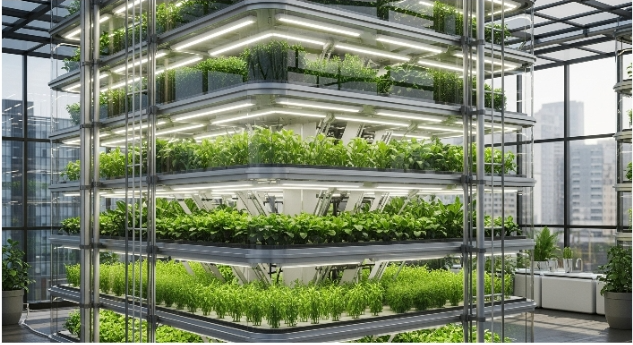
Explore how strategic tower design and technology integration make commercial vertical farming more cost-efficient and scalable.
Vertical farming has become a promising solution for sustainable food production, offering consistent yields regardless of climate or location. Yet for many commercial growers and agribusiness investors, the biggest hurdle to adoption remains the same—high setup costs. From LED lighting to climate control systems, launching a fully functional vertical farming tower requires substantial upfront capital.
However, as the sector matures, design innovations and technology partnerships are reshaping what’s financially possible. Understanding where costs arise—and how to manage them—has become essential for anyone considering vertical agriculture at scale.
The Economics Behind Vertical Farming Investments
The potential of vertical farming lies in its efficiency: higher yield per square foot, reduced land use, and localized food distribution. But these advantages come with significant entry costs. For large-scale operators, the initial investment typically ranges from $150 to $400 per square foot, depending on tower type, automation level, and crop selection.
Energy expenses remain the largest operational burden. Lighting, nutrient delivery, and climate control consume substantial electricity, often accounting for more than 50% of ongoing costs. For corporate investors, this raises critical questions around ROI timelines and cost predictability.
Despite these challenges, reports from the U.S. Department of Agriculture (USDA) show that improved LED efficiency and modular tower systems are reducing costs year over year. Early adopters who integrate renewable energy sources or smart automation often achieve payback periods of 3–5 years, compared to over a decade in earlier models.
Design Efficiency: The Role of Technology and System Integration
A well-designed vertical farm begins with a scalable structure. Advanced hydroponic tower systems now allow growers to expand incrementally rather than committing to full-scale infrastructure from the outset. This modular approach not only minimizes initial costs but also supports more agile responses to market demand.
Modern vertical farming tower designs incorporate intelligent irrigation, pH regulation, and remote monitoring technology. This integration ensures uniform nutrient delivery while minimizing water waste—a key advantage in sustainable agriculture. According to the Controlled Environment Agriculture Alliance (CEAA), precision-controlled hydroponic towers can reduce water consumption by up to 90% compared to traditional soil farming.
When coupled with automation and data analytics, these systems also streamline labor requirements. Automated nutrient dosing and AI-based climate optimization can replace hours of manual oversight, improving both consistency and profitability.
Energy Use and Sustainability: Finding the Right Balance
While energy efficiency remains a concern, the vertical farming sector is rapidly closing the gap between sustainability and profitability. New LED technologies consume up to 40% less power than previous generations, while solar and geothermal integrations are being used to offset grid dependency.
Forward-thinking agribusinesses are also exploring energy recapture systems, which reuse heat and CO₂ from lighting to promote plant growth. These sustainability measures not only reduce operating costs but can also help organizations meet ESG (Environmental, Social, and Governance) benchmarks increasingly demanded by investors.
As more jurisdictions incentivize renewable energy use in agriculture, farms leveraging smart energy systems stand to gain both operational savings and reputational advantages.
Scaling Without Compromising Quality
For many growers, scaling a vertical farm is as much about logistics as it is about growth. Over-expansion without infrastructure readiness can create bottlenecks in nutrient distribution, data tracking, and climate control.
The most successful commercial models focus on gradual scalability—replicating proven tower designs across multiple facilities rather than overloading a single structure. This strategy simplifies training, maintenance, and quality control.
Using data-driven forecasting tools also allows operators to model yield projections against capital expenditure. By identifying performance patterns, growers can optimize production without overspending on unnecessary infrastructure upgrades.
Aligning Crop Strategy with Market Demand
Another overlooked factor in managing startup costs is crop selection. Certain crops deliver faster returns due to higher turnover rates and consistent local demand. Leafy greens, herbs, and microgreens remain the most profitable staples of vertical farms, while fruiting crops like tomatoes or peppers often require additional light and nutrient inputs.
Commercial operators increasingly rely on market data to guide crop diversification. When paired with efficient hydroponic tower systems, growers can respond to shifting consumer trends without redesigning their entire layout. This flexibility not only protects margins but also ensures long-term market relevance.
Conclusion
While high initial costs have slowed vertical farming’s widespread adoption, the industry’s trajectory is clear. Modular designs, smart technology integration, and sustainable power solutions are transforming how businesses approach profitability in agriculture.
For commercial growers and agribusiness leaders, success in vertical farming no longer depends on large-scale investment alone—it depends on strategic design, efficient resource use, and data-informed decision-making. The future of sustainable agriculture belongs to those who can innovate efficiently, growing more with less.
Additional Resources
Explore next-generation commercial hydroponic systems engineered for scalable food production and long-term sustainability.

